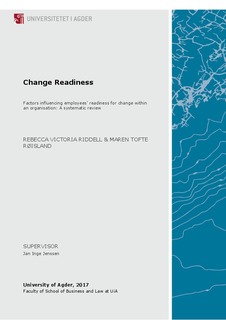| dc.description.abstract | External and internal factors are constantly forcing organisations to change; in order for organisations to survive and change successfully it is crucial to respond quickly. Readiness for change and actions undertaken in the implementation of change serve as key constructs for the success of a change effort. Readiness for change is well known as a tool for decreasing resistance to change, but exactly what factors will create this condition and in what order the steps must occur has been studied less extensively. The term readiness for change goes all the way back to Kurt Lewin’s (1951) three-step model, in which the first step, unfreezing, refers to the creation of change readiness. Armenakis, Harris & Mossholder (1993) later expanded this approach by making their own model for readiness for change called the ‘message’. The model is well-known in the field of readiness for change, and consist of five components; (a) discrepancy; (b) principal support; (c) self-efficacy; (d) appropriateness; and (e) personal valence. Change readiness or readiness for change can be defined as how the attitudes, beliefs, and intentions of an organisation’s members recognise the need for change as well as the organisation’s own capability to accomplish these changes (Armenakis et al., 1993).
We chose to conduct a systematic review using a narrative synthesis approach. Our aim was to collect various studies and articles, both qualitative and quantitative, in order to extract evidence regarding the factors that have the biggest impact on readiness for change. We started by collecting 500 articles, and after going through several exclusion processes, we ended up with 26 articles. These 26 articles were then analysed and systematised in various tables. Results show that the factors of ‘the message’ (especially self-efficacy), transformational leadership, development climate, participation, trust in management, organisational justice, and commitment had the greatest impact on change readiness, both directly and indirectly. These results were also supported by the literature on change readiness. Further, we constructed a model to show the most efficient way of gaining successful change readiness within an organisation. | nb_NO |

